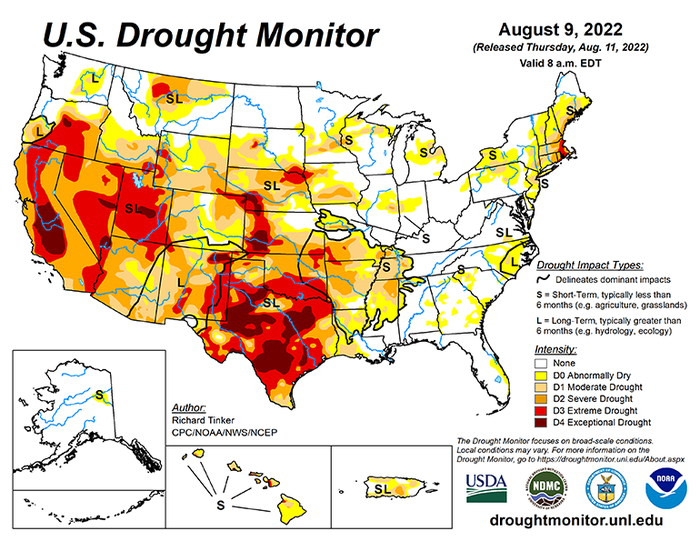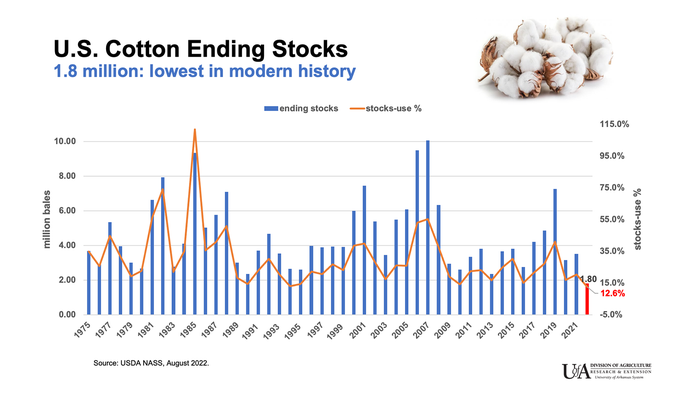August 22, 2022

“These are absolutely stunning adjustments in the U.S. cotton balance sheet." -- Scott Stiles
The United States is expected to harvest its lowest number of cotton acres since the 19th century, according to an estimate from the U.S. Department of Agriculture.
“USDA projected this year's harvested acres at 7.13 million,” said Scott Stiles, extension economist for the University of Arkansas System
Stiles said USDA’s Aug. 12 report projected that about 43% of U.S. planted cotton acres are expected to be abandoned this year, “largely due to the extreme drought conditions in the southwest region, which includes Texas, Oklahoma, and Kansas.”

Drought monitor map released Aug. 9, 2022, still showing intense drought in the American SW. (Drought Monitor image)
Texas was particularly hard hit by drought this year.
“Texas is projected to abandon 69% of its cotton acreage this year,�” Stiles said. “Texas' planted acreage was 7.1 million. Texas farmers are expected to harvest just 2.2 million, the lowest since 1879.”
Stiles said that ahead of each monthly USDA report, Reuters surveys a group of industry analysts.
“The lowest pre-report estimate for production was 14 million bales. The actual number came in at 12.57 million,” he said. “This was a huge 2.93-million-bale drop from the July production estimate of 15.5 million. Lower production resulted from a reduced U.S. average yield estimate and a 1.4-million-acre reduction in harvested acres.”
Reduced outlook
Given the lower production estimate, USDA reduced its outlook for 2022 exports and domestic mill use by 2.2 million bales. The key metric of ending stocks was reduced 600,000 bales this month to a record low 1.8 million bales.
“These are absolutely stunning adjustments in the U.S. cotton balance sheet,” Stiles said.
Friday's report sent cotton futures up the daily limit of four cents, with the December 2022 contract closing at just under $1.09.
The daily trading limit was expanded to five cents in Monday's trading. Within minutes of the open Sunday night, the December contract traded the five-cent limit, reaching $1.1359. USDA currently forecasts a record season average farm price of 97 cents per pound for the 2022 crop.
Estimates for Arkansas
 Cotton ending stocks, from USDA/National Agricultural Statistics Service numbers. (Scott Stiles, U of A System Division of Agriculture)
Cotton ending stocks, from USDA/National Agricultural Statistics Service numbers. (Scott Stiles, U of A System Division of Agriculture)
USDA projected Arkansas' state average yield to be the second highest on record at 1,195 pounds per acre. Arkansas set a record high last year, with a state average yield of 1,248 pounds per acre. That beat the previous record of 1,185 pounds per acre set in 2019.
Stiles said the National Agricultural Statistics Service will conduct its regular in-field sampling for its September production estimate.
Bill Robertson, extension cotton agronomist for the Division of Agriculture, said NASS was estimating 500,000 acres of cotton in Arkansas, but “we have 600,000 acres based on boll weevil eradication measurements with lots of new growers and cotton on less-than-optimum ground. This will impact our yield average.”
Irrigation management during this season’s high temperatures will make the biggest difference for growers.
“Those who started irrigation on time have a good crop. Those who started late cut their effective bloom period short with an early cutout. This will impact our yield average,” he said.
“Cutout,” in the parlance of cotton production, is the point in the plant’s growth during which it won’t support the production of additional bolls.
“An almost ideal September will be needed for the plants to fill and mature bolls needed to obtain the yields and quality we have been accustomed to producing,” Robertson said.
Source: University of Arkansas System Division of Agriculture, which is solely responsible for the information provided and is wholly owned by the source. Informa Business Media and all its subsidiaries are not responsible for any of the content contained in this information asset.
You May Also Like




